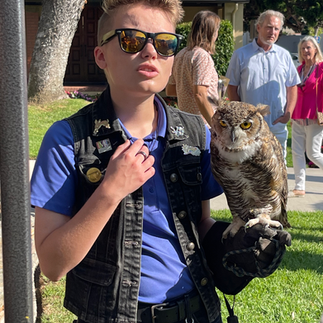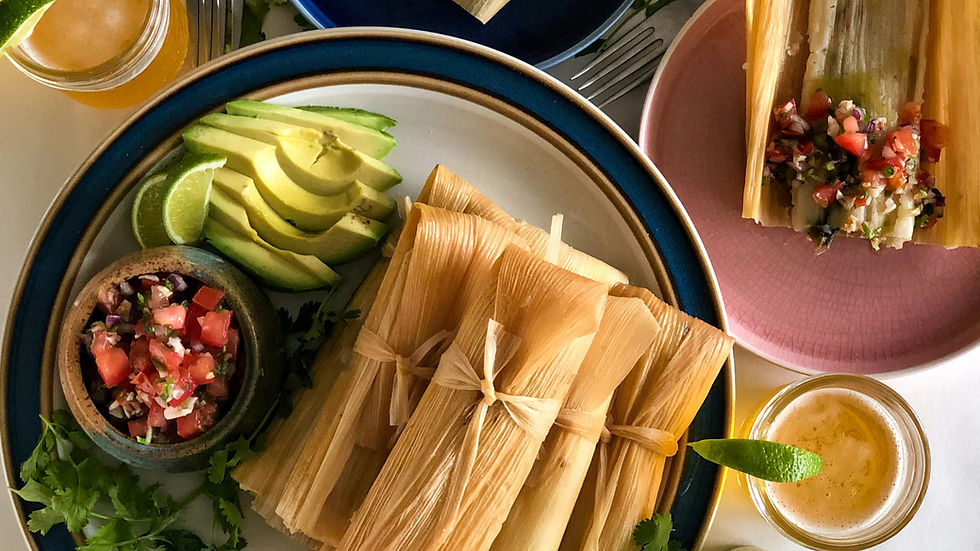Temporary Crow Exhibit Takes Flight in Laguna Beach
- Jessica Peralta

- Aug 16, 2024
- 6 min read
Updated: Aug 16, 2024
“Attempted Murder” serves as a showcase and the backdrop for education about birds of prey.

The Laguna Beach community got a public art activation fully themed in birds this month with a visit from the Orange County Bird of Prey Center landing during a crow-themed exhibit in front of city hall.
Northern California artist Jack Champion installed his “Attempted Murder” exhibit July 12 on the front lawn of Laguna Beach City Hall. The exhibit features two 1,000-pound bronze crow sculptures that will continue on display through Sept. 20.
“Three or more would be called a murder — such as a gaggle of geese — therefore (this) is an ‘Attempted Murder,’” said Siân Poeschl, cultural arts manager for the city of Laguna Beach, describing the play on words of the exhibit title.
The temporary exhibit is the second of three installations outside city hall for 2024. The first was titled “Dream Big” by Elizabeth Laul Healy, and Poeschl said the December exhibit will remain a surprise for the community.
The city expanded the “Attempted Murder” exhibit with a special educational activation that partnered with Orange County Bird of Prey Center for an hour-long event on Aug. 1. Volunteers came out to speak in front of city hall about their organization and local birds of prey, with three live raptors perched on volunteers’ gloved arms that community members could see up close.
“We have a Western screech owl, a great-horned owl and a red-tailed hawk. All three are wild-born birds that were brought to us with injuries that resulted in them being non-releasable,” said Joanne McDermott, director of administration for the Orange County Bird of Prey Center.
“In general, as an organization, we try to rehabilitate wild birds and get them back out into the wild as soon as possible. If a bird is non-releasable for any one of a number of reasons, it only has a few options: It can either go to work as a display bird like in a zoo. It can be euthanized. Or if its temperament is well suited for education, we work with them and get them accustomed to people so we can bring them out and do education with them. All three birds that we have today are non-releasable, and are veteran, education birds.”
She said they take in injured birds of prey like owls, eagles, hawks, falcons, vultures, osprey and kites. The birds come in through local animal control, OC Parks rangers, outside the county and good Samaritans.
“They start off their journey at Serrano Animal and Bird Hospital in Lake Forest. That’s where Dr. Scott Weldy, who is the veterinarian that helped found our organization, it’s his practice,” McDermott said. “He does the triage on the birds — if they need surgery, he’ll perform that. And then they come to our facility for rehab. It’s a chance for them to eat and build up their strength and work their muscles and get themselves healthy and ready for release.”
PHOTO 1: Orange County Bird of Prey Center held an hour-long event on Aug. 1 with volunteers speaking in front of Laguna Beach City Hall about their organization and local birds of prey. As a part of this exhibit, wings of various birds were on display. PHOTO 2: Orange County Bird of Prey Center Director of Administration Joanne McDermott with Wilson the Western screech owl, answers visitor questions about local birds of prey. PHOTO 3: McDermott with Wilson the Western screech owl in front of the “Attempted Murder” exhibit. PHOTO 4: Volunteer Kass Malcor with Tweek the great horned owl. PHOTOS 5 and 6: Volunteer Heather Stark with Hank the red-tailed hawk. Photos by Jessica Peralta, Culture OC
A Passion for Birds and Art
Champion has a long-standing fascination with birds.
“I've always been intrigued by crows,” he said. “They are such intelligent animals .… I lived in Marin County in a little town called Fairfax for about 25 years. And in that time … I had been friended by a group. I guess I used to feed them off the deck of my house and they would recognize me, you know, and … they would recognize my truck even.”
He originally created five large crow sculptures for Burning Man arts and culture festival — where he also worked construction — in 2016. They weighed 200 pounds each and were made of fiberglass. He sold all of those at Burning Man. He made five more and has sold most of those as well. And then in 2018, he made the two bronze versions that are currently in Laguna Beach. Those were also displayed as part of a Smithsonian in Washington, D.C. show featuring the art of Burning Man, called “No Spectator.” The bronze crows are for sale as well — as a pair.
“I'd like to get $300,000 for the set of them,” Champion said. “The pair, I don't want to separate them.”
Champion’s art often plays with perspective. In fact, he just completed a very large cricket made of brass that’s about 20 feet long and 6 feet high. The large crows were inspired by his time in the desert during Burning Man.
“When I came up with this concept, I was working in the desert at Burning Man,” he said. “We were building a temple with this group and I was kind of head of the construction there and we had construction lights on throughout the night. And in the morning, I would go out there and shut the lights off like at 6 o'clock and there’s all these bugs … would fly into the lights and die and they'd be on the ground .… I'd walk out there and I'd see these crows. I'm like, where did these crows come in this vast landscape? You know, there’s no tree for miles and miles around and they're out there, picking the bugs off the ground and eating them .… I thought how odd that was and I decided to play with that perspective.”
Jack Champion's oversized bronze crows which are a part of his “Attempted Murder” sculptures are 1,000 pounds each. On right, the scale of the size of these sculptures can be seen as Orange County Bird of Prey Center Director of Administration Joanne McDermott answers visitor questions with Wilson, the Western screech owl. Photos by Jessica Peralta, Culture OC
Poeschl said the idea behind this collaboration stemmed from crows being misunderstood and that by partnering with the Orange County Bird of Prey Center, people could learn about various types of birds and their habitats.
“And maybe think of it differently about the canyon habitats that we live in and how we can do better to protect not only the birds of prey but birds like crows,” Poeschl said. “It seemed like a great collaboration, a great activation in a way that people get to see live animals against the temporary installation but really give the pieces more meaning.”
Poeschl said the city has had temporary installations outside city hall for the past seven years and is committed to highlighting a variety of genres, artists and experiences. The city has several temporary installation sites. Poeschl said the installations are through a Call for Artists Proposals and the call is currently closed, but will reopen again early in March 2025.
“The city of Laguna Beach Arts Commission is committed to sharing temporary exhibitions broadening the experience of public art to residents and visitors,” Poeschl said. “These varied temporary installations highlight the values of the community as well as how we see our permanent environment in a different way. By being physically present in our streets, public art sparks imagination and conversation, but because it is temporary, it encourages us to cherish the limited time we have it.”
McDermott said education is a priority for their group.
“We believe that the real key to conservation is through education,” McDermott said. “So whether we’re educating the next generation at school talks or whether we’re educating the general public through events like this, we think the most important things we can do for these birds is educate the public — about what to do if they find an injured bird, also behaviors they can change to give the birds a better chance in Orange County .… Most of the threats to them are anthropogenic, which means they stem from human activity.”
If you find a bird, the best thing to do is leave it in place — especially if it’s a young bird. Its parents are likely around as it learns to fly. If it seems injured — it’s bleeding or appears to have a broken wing — call your local animal control.
“One of the most important things is to stop using rat poison,” McDermott said. “Rodenticides are a big problem because they go right up the food chain. The rats ingest the poison. Then they go out and walk around. They can get eaten by not just raptors, but bobcats, coyotes, mountain lions. And we’ve seen that rat poison in all of these higher level predators. There’s no need to use rat poison. If you have a healthy raptor population, they’re gonna do a better job than the rat poison is. A single barn owl, for example, consumes 700 rodents a year. So if you have a family of barn owls — two adults and four babies in your vicinity — they’re doing a tremendous job of natural pest control.”





















.png)









